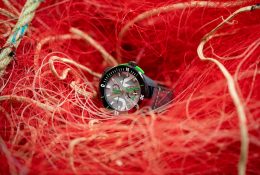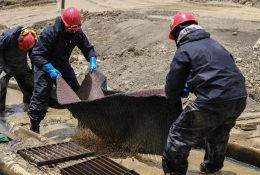It has the classic good looks of a 41mm steel case with a black, blue or grey dial, three hands and an unobtrusive date window at 3 o’clock. The first watch from newcomer ID Genève, the Circular 1 doesn’t break any design moulds. Instead it challenges traditional production models, based on a linear system of “buy, use, throw away”, with a circular system that reuses resources. “This is something we’d been wanting to do for years,” says co-founder Nicolas Freudiger. “Once we started planning the project, we knew the way forward was to have a strong identity rather than a distinctive design. We set ourselves three goals: that 100% of the materials come from the Swiss circular economy; that we change people’s image of recycled materials in high-end watchmaking, and encourage greater sustainability within the industry.” Quite an ambitious project for a brand that launched less than a year ago, after a campaign on the Swiss crowdfunding platform, wemakeit.
100% recycled and traceable steel made from scrap collected by local businesses in the watch and medical sectors.
Thanks to the CHF 315,000 raised in 45 days, the brand was able to launch production of 300 Circular 1 watches. The steel for the case is recycled out of waste collected within a 200-km radius from businesses in the watchmaking or medical sectors and is fully traceable. Carbon emissions are ten times lower than for conventional steel. The automatic movements are sourced from unsold inventory. They are disassembled, cleaned, reassembled, oiled and adjusted to be better than new, making them virtually carbon neutral and with a slightly higher cost than for new movements. Straps are made from biomaterial that contains 80% recycled grape residue, with no plastic or chemical additives. Part of the same virtuous circle, packaging material is made from mushrooms that are grown around a mould and can be added to a home compost.
Transforming a problem into a solution
ID Genève hasn’t gone it alone. The brand’s founders have put together a solid network of partners that includes Panatère for the cases. The company was set up five years ago by Raphaël Broye, who had the smart idea to transform a problem into a sustainable solution. “We’ve been supplying the watch industry for forty years,” he explains. “Five years ago we ran into major supply problems. None of the big European steelmakers were interested in supplying us with quality steel in small quantities. Our solution was to form a network of companies in the Jura region that supply the watch and medical sectors. All the scrap steel from our factories went into on-site sorting bins. After four years we put it all together and were able to produce our first 50 tonnes of recycled and recyclable steel.”
Track and trace
The biggest challenge was to develop a system that would transform scrap into steel of the highest quality, without the addition of chemicals or ore. “We had to set out a strict process if we were to achieve our goal of virtually zero-carbon production,” Raphaël Broye continues. “The first step involves highly selective sorting of the steel scrap and shavings. The different grades are separated into bales which are scanned to guarantee traceability before being sealed. This secondary steel goes to two foundries, both within a 250-km radius, where it’s transformed into ingots which then go into storage. Panatère can currently produce 50 tonnes of recycled steel every six months. It’s a drop in the ocean compared with the 120,000 tonnes of stainless steel used in Switzerland each year, all sectors combined. But the Circular Economy Switzerland label is making headway and could inspire similar initiatives.”
The company, which is based in Saignelégier, is exploring other sustainable avenues. “We’ve already melted our first ingot in a solar furnace in the French Pyrenees,” enthuses Raphaël Broye. “An identical solar furnace in Watch Valley would enable us to produce around 200 tonnes of solar steel per year.” Increased supply of this steel, whose carbon emissions are 165 times lower than a conventional equivalent, is a first step towards more widespread use in the watch industry, and a more sustainable watch on our wrist.


















